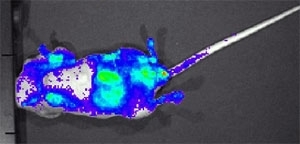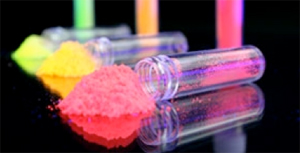Sometimes during summer you might see a tiny flashing light at night. It could be the light from a small firefly. There are lots of things that glow in the dark. Some things like fireflies make their own light. This is called luminescence. You see it because the firefly produces light at a wavelength that you can see with your eyes. Light has different wavelengths. That is what makes things look different colors. Some wavelengths of light you can see, other kinds of light you can’t see.
There are other things that glow but only when you shine a light on them. This is called fluorescence. Fluorescence is when a chemical absorbs light at one wavelength and shoots out light at another wavelength. Black light posters are made of a material that is fluorescent. Shine an ultraviolet light (looks dark blue) on the poster and it glows with a yellowish green color. Turn off the light and the poster stops glowing.
 Nanotechnology is being used to create very tiny particles that have great fluorescent properties. Made of chemicals like cadmium and selenium, these tiny particles called quantum dots are only a few nanometers in size. So small that they contain only a thousand or so atoms. Together they form a semiconductor, the same stuff used to make computer chips. They are so small that they don’t have any space to store energy. So when you shine a light on them, they get excited and then fire off a photon, a little light particle. They glow! Scientists can make many different colors of quantum dots by making them different sizes. This is what nanotechnology is all about–making useful things — because sometimes really tiny, nanoscale-size stuff has really amazing properties.
Nanotechnology is being used to create very tiny particles that have great fluorescent properties. Made of chemicals like cadmium and selenium, these tiny particles called quantum dots are only a few nanometers in size. So small that they contain only a thousand or so atoms. Together they form a semiconductor, the same stuff used to make computer chips. They are so small that they don’t have any space to store energy. So when you shine a light on them, they get excited and then fire off a photon, a little light particle. They glow! Scientists can make many different colors of quantum dots by making them different sizes. This is what nanotechnology is all about–making useful things — because sometimes really tiny, nanoscale-size stuff has really amazing properties.
What can we do with quantum dots? Scientists and doctors are making quantum dots to see inside of the body. Kind of like using X-rays, except these could be safer and maybe see things really small. One big advantage is their tiny size but a more important they don’t wear out. Some fluorescent materials eventually lose their ability to absorb light, and they don’t glow any more after long periods of being exposed to light. Quantum dots for reasons that still nobody understands don’t stop working, they keep on glowing.
Images Source: Evident Technologies

